Peeling skin can be caused by a variety of factors. To deal with ...


Ficus (Ficus) belongs to the Mulberry family. It is a light-loving, shade-tolerant, deciduous ornamental plant. Today this plant is one of the most common among indoor flowers, is especially popular with florists and beginners. According to various literary data, the genus Ficus has from 800 to 1000 species of evergreen, deciduous shrubs and woody lianas. But only 20 types of ficus are considered indoor. Ficus grows in tropical and subtropical regions of various continents - America, Australia, Africa, Asia, the Mediterranean, on the islands and coasts of the Indian and Pacific Oceans.
It is known that most species of ficus in nature reach enormous size; these are thick, branched trees that give a thick shade. There is such a fact, for example, in Bengal there are specimens that are capable of covering an area of 1 hectare with their crown.
Indoor ficuses are considered centenarians and, having planted such wonderful plant on your windowsill, you will admire the plant for a long time. Ficus leaves are very diverse in thickness and shape, as well as in color.
In the Buddhist tradition, the ficus is considered a cosmic tree, it is called the "tree of enlightenment" or "Bo".
Now your attention is provided with a description and characteristics of the most common types of ficus that are grown indoors.
Ficus rubbery Ficus elastica(Ficus elastica) , it is a large and branching shrub.
Leaf characteristic: the leaves are beautiful, dense, 30 to 45 cm long, elongated-oval, pointed at the ends. Growing at home with optimal conditions, the plant turns into a tree up to 2 meters high. The mature leaves are green in color, while the leaves of young plants are bronze in color. This view Plants will perfectly fit for landscaping winter gardens, foyers and shop windows. V winter gardens small figs appear on older individuals - they are inedible.
The Himalayas, Burma, Nepal, the tropics of India, Sri Lanka, and West Africa are considered the birthplace of rubber ficus. In these zones, the tree can grow up to 25-30 meters high. WITH historical facts it is known that in the 19th century they learned to grow a narrow-leaved form. Variegated forms are harder to grow than green forms.
In astrology, rubber ficus is a plant of Capricorn, and affects a person on a physical and emotional level.
We bring to your attention the most common forms of rubbery ficus:
Caring for such forms of rubber ficus, it is necessary to monitor the purity of the leaf plate.
Be careful, if a leaf or cutting is damaged, the ficus releases poison.
During dormancy, with excess moisture or too dry soil, rubber ficus can shed its leaves.

 Ficus benjamina Ficus benjamina
Ficus benjamina Ficus benjamina (Ficus benjamina) , it is a large spreading bush or a small tree with dense foliage, the stems are penetrating. The leaves are small, elongated and pointed at the ends. Their length is from 3 to 8 cm, they are oval, rigid, mono and variegated, in appearance waxy. V natural conditions This shape allows excess moisture to drain off during the monsoon. Ficus Benjamin has thin and weak shoots, they need to be shaped so that the plant looks neat. Shoots can stretch out without forming, the bush will be one-sided. Ficus Benjamin tolerates a haircut normally, only the cut points need to be processed with crushed coal. There are times when several plants are planted in one pot; as they grow, their trunks are intertwined into a "pigtail".
The popularity of this flower is growing very much, since the flower fits perfectly into a modern interior.
 Ficus lyre Ficus lyrata
Ficus lyre Ficus lyrata (Ficus lyrata) , this is a small tree or shrub of impressive size. Has dense petioles. Erect and not very branched.
Leaf characteristic: leaves are hard, 25-45 cm long, bright green in color, with embossed light veins, have a waxy coating and wavy edges. Guitar-like in shape. V young age leaves are slightly pubescent. No aerial roots. The plant needs good lighting... When hitting straight sun rays burns may occur.
 Ficus pumila Ficus pumila
Ficus pumila Ficus pumila Dwarf ficus or pumila(Ficus pumila) , decorative climbing small-leaved view (ampelous view). The plant is perennial, does not shed foliage, flexible wire-like stems, give layering. The length of the leaves is from 2 to 5 cm, in shape - heart-shaped, thin, in color - green, matte on a thin stem. Young shoots are asymmetric plates. The length of the shoots is up to 5 m, if the plant is propagated vegetatively with such shoots, then in the future the asymmetry will remain in the adult plant. China and Japan are considered the birthplace of the pumila.
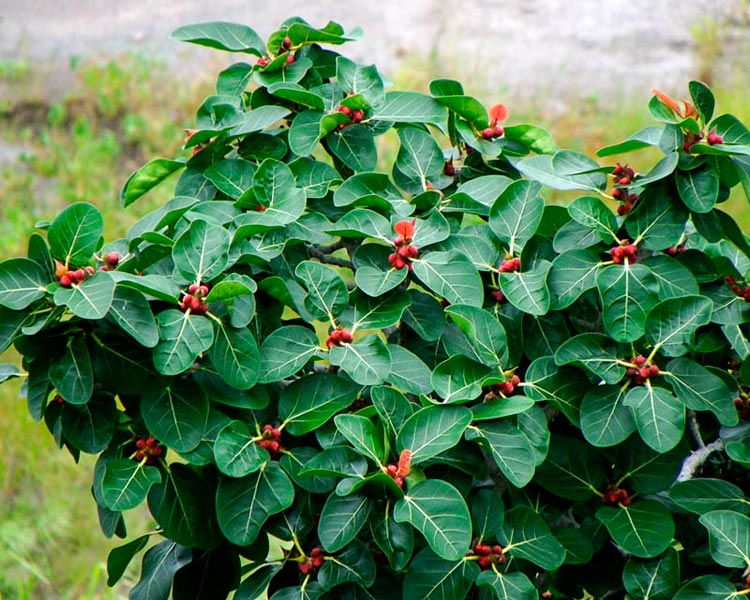 Ficus Bengal Ficus benghalensis
Ficus Bengal Ficus benghalensis (Ficus benghalensis), in other words, the "World Tree" is a symbol of endless reward and immortality. The evergreen tree has sprawling and powerful branches. Long aerial roots, formed in natural conditions... The bark of the Bengal ficus is smooth, grayish-brown in color. In color, the leaves of the Bengal ficus are dark green; oval in shape, with a sharp tip. Leaves are dense and velvety, 15-25 cm long with big amount veins. Bengal ficus in a pot grows up to 3 m in height. This flower needs a spacious room.
Ficus, Ficus - evergreen trees, shrubs, vines with small flowers and decorative leaves containing milky juice.
The genus is the ancient Greek name for the fig tree.
Ficuses are one of the most popular plants in floriculture, because thanks to the variety of shapes and sizes, you can always choose a specimen that suits your interior.
The genus includes about 800 species of trees, shrubs and lianas that grow in the tropics and subtropics of both hemispheres.
Evergreen tree, in nature up to 30-40 m tall. The bark is grayish brown, smooth, thick. The leaves are large, leathery, oval up to 10-30 cm in length, arranged in a spiral.
Evergreen creeping or climbing shrub. Shoots are long, thin, provided with numerous adventitious roots. Characteristic feature a species is the variability of its leaves with the age of the plant. In young creeping shoots, these are small (2 cm long, 1 cm wide) asymmetric leaves. In adult plants, large, hard leathery leaves of a regular oval shape appear on the shoots.
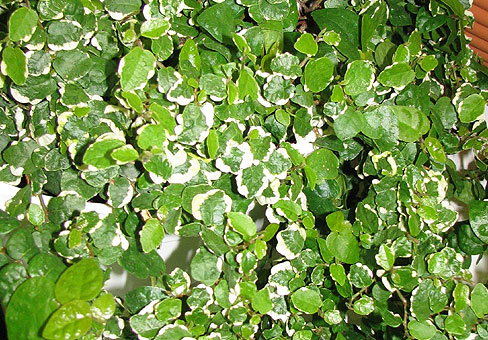
Popular varieties of Ficus tiny:
« White Sani»- leaves with a wide creamy border;
« Dort" - leaves beautiful shape with golden splashes;
« Sled»- leaves with an intermittent creamy border.
Deciduous tree or shrub, in nature 5-12 m high. Shoots are thick, slightly branched. Leaves are palmate, less often whole, with a rough-rough surface. Inflorescences are spherical or pear-shaped, hollow. On the inner wall of the overgrown receptacle are located small flowers, the so-called syconium. Siconias are of three types: male, female with short columns, and female with long columns. Plants are dioecious. Pollination is done by insects.

An evergreen tree, in nature up to 20 m in height. The bark of young plants is dark brown, in adults it is light gray with white strokes. The leaves are long and narrow, up to 25 cm in length, leathery, glossy, pointed. The leaf blades are slightly concave along the central vein.
Popular varieties of Ficus binnendijka:
- a widespread variety with a dark brown trunk with white strokes;
« Amstel Queen" and " Amstel King»- the leaf blade reaches 7 cm, the trunk is dark brown with numerous white streaks;
« Variegata"- variegated variety.
Small-leaved species and varieties of ficus, for example, Benjamin Ficus, can be formed in the form geometric shapes... For simple forms trimming is enough, for complex sculptures a wire frame is used.
An evergreen tree in nature up to 10-20 m high. Shoots are thin, drooping, aerial roots extend downward from them. The leaves are alternate, shiny, up to 5-10 cm long, 2-5 cm wide. The fruit is paired or single, 1.2 cm in diameter. There are variegated forms.
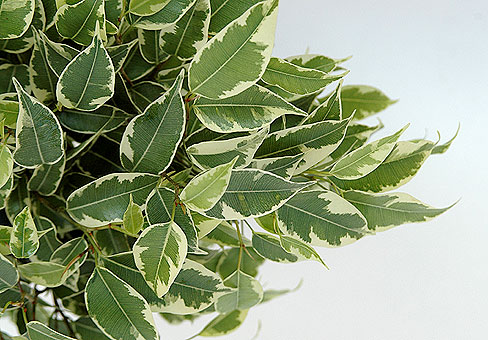
Popular varieties of Ficus Benjamin:
« Hawaii»- leaves with white spots;
« Golden King»- leaves with a whitish edging and gray-green spots;
« Naked»- narrow, slightly wavy leaves, lateral shoots partially drooping;
« Israel- leaves with a strong gloss, large, gray stems, drooping shoots;
« Dwarf gold»- the leaves are small green, grayish with age, the edges of the leaves are white;
« Starlight»- leaves are dark green with a white border;
« Exotic- leaves with a strong gloss, brown color on young shoots and along the central veins.
An evergreen tree 20-30 m high. It has aerial support roots. Leaves are oval, 20-30 cm long, 10-20 cm wide, dark green, shiny, leathery, with a pronounced midrib. Young leaves are twisted into a tube and covered with reddish stipules. In culture, variegated forms are found.

Evergreen tree 10-12 m high. Leaves up to 60 cm long and 30 cm wide, lyre-shaped, with a wavy edge, dark green, leathery. There are no aerial roots.
Evergreen tree with aerial roots- supports. Looks like Ficus Benjamin. It differs from the latter in horizontally spread non-hanging shoots and denser leaves.
Ficuses are widely used as large tapeworms, in potted groups, as ampelous, and also for vertical design.
Ficuses are unpretentious and shade-tolerant, except Ficus caric... Some of them (for example, Ficus lyre and Dwarf ficus) need high humidity air. The temperature in winter is maintained within the range of + 10 ... + 15 ° С. Watering is plentiful in spring and summer, moderate in winter. Plants do not tolerate overdrying of an earthen coma. The plant should be regularly sprayed with soft water. In the warm season, top dressing is carried out every 2-3 weeks.
Plants easily tolerate pruning and need crown formation. Ficus pruning is done to rejuvenate the plant, give it a certain shape, prevent tree species exposing the trunk, causing branching in the right place, changing the direction of growth of branches and for sanitary purposes. Pruning and replanting at the same time is not recommended as this can weaken the plant. In addition, weakened and painful plants should not be subjected to formative pruning.
Ficuses are transplanted in the spring: young plants annually, adults - every 3-4 years. Preference should be given to spacious containers, 1/4 filled with drainage material. For large specimens, crushed stone is used as a drainage material. This provides the container with stability by making the bottom heavier. Used by soil mix from turf, compost, peat and sand (1: 1: 1: 1). When moving and replanting large ficuses, it is necessary to ensure that the most developed part of the crown remains facing towards the greatest illumination, as it was before the rearrangement.
Ficuses do not tolerate the rotation of the crown relative to the light source. The exception is Ficus rubber- it should be rotated relative to the light source to form a symmetrical crown.
Propagated by cuttings in spring. The milky juice released from the cut shoots is washed off with water, after which the cuttings are planted in a wet mixture of peat and sand (1: 1), rooted at a temperature of +25 ... + 30 ° C at high humidity air.
The substances that these plants secrete are biologically active and serve as a source of improvement in the air environment, which has a positive effect on the human body. By creating " fresh air», Ficus helps to improve performance, overcome stress, normalize sleep. But ficus also has other amazing properties. It belongs to filter plants, its leaves are capable of absorbing formaldehyde up to 10 mt / h. This colorless gas is often found in the air of rooms and kitchens (released from particle boards, plywood, polystyrene and other polymer materials used in the decoration of premises). This invisible pest causes irritation respiratory tract, constant headache, sometimes - nausea. Place 2-3 ficuses indoors on an area of 16-20 square meters. m, which will significantly improve the environmental situation.
One of the best air purifiers in an apartment - Ficus Benjamin... Due to the dense arrangement of stomata on the leaves, it carries out intensive gas exchange with the surrounding air environment, absorbing many harmful compounds, such as benzene, trichlorethylene and phenols, toxic to humans, and converting them with the help of special enzymes into amino acids and sugars.
Dwarf ficus, or small-leaved, known as Creeping ficus, widely used in folk medicine... The leaves are used to treat dysentery, hemorrhoids. Dried leaves and stems - for furunculosis, rheumatism, ulcers in the larynx. The juice from the stem is recommended for skin diseases, and the stem itself and the skin of the infructescence are recommended for back pain, cancer, indigestion, dysentery, gonorrhea, hernia, etc. oriental medicine the plant is considered to increase sexual performance, at least male potency... Consuming this herb internally relieves heart pain and prevents the risk of cancer.
From a therapeutic point of view, it is interesting and Ficus carica (fig tree, fig). In medicine, the whole plant is used as an anti-cancer agent. A decoction of the leaves is effective for pain and helps to reduce hemorrhoids, warts. Compound fruits are a means of promoting digestion and lactation in lactating women.
Ficus works like a vacuum cleaner that cleans the space from the dust of our worries, doubts, experiences. Sadness and anxiety weaken the energy of our apartments and disturb the vibrational balance, which affects the state of the atmosphere as a whole. And this is especially true for houses that are located in the city center. Ficus, as it were, takes fire upon itself, absorbing negative energies and transforming them into positive ones.
There is a belief that the ficus contributes to the conception and birth of children, although it is rather difficult to confirm or refute such a statement. But the ficus really affects the energy balance: it relieves irritability, acting as an immune psychotherapist, transfers to a person its state of peace, poise, a sense of stability in life. He extinguishes aggression in hot-tempered people, and gives decisiveness and determination to those who are insecure.
Ficus - evergreen tree, belonging to the mulberry family. It is widely distributed in India, Nepal, Japan, Burma, China and Ceylon. The following species are most often grown in rooms:
Tiny ficus is a plant with a climbing stem and thin, wire-like branches. The leaves are small, asymmetrical, thin. Young ones are heart-shaped, old leaves are oval. The plant can be a wonderful decoration for almost any room: an apartment, large hall, office, winter garden;
Ficus Benjamin has drooping shoots and dense green leaves. Some varieties of this species have leaves with yellow and white spots;
Rubber ficus is a plant with large smooth green leaves;
Ficus pandurata has large leaves, shaped like a guitar.
There are many ampelous forms, for example, ficus rooting with variegated leaves and dwarf ficus, characterized by small leaves.
Light-loving plant.
Moderate watering is sufficient.
Top dressing is required once a month.
All varieties of ficus are unpretentious and undemanding to lighting and air humidity. In the spring-autumn period, the ficus requires abundant watering.
Apmel forms require support - a wooden lattice or wire. Without it, the shoots will hang down.
In summer, the plant needs abundant watering; in winter, watering should be reduced. In the warm season, the leaves and air in the room must be regularly sprayed. The plant should be fed once a month with mineral fertilizers.
Young ficus can be grown from apical cuttings. To do this, you need to cut off the stalk, on which at least two or three buds have formed, dry it a little, plant it in wet sand for rooting, and after a while transplant it into the soil.
Scabbards and spider mites cause great harm to the plant. Excess moisture, lack of lighting, and drafts can cause yellowing or falling leaves.
Ficus- not a separate plant, but a family. Trees, shrubs, and lianas are also led into it. Most of them are large, not suitable for growing in apartments. But, outside of them, ficuses began to be cultivated even before our era. The fig tree, for example, is recognized as the most ancient horticultural culture.
The Arabians began to grow it, and after them the inhabitants of Phenicia. This country, apparently, is even named after fig tree... Another member of the family is revered in India and other Buddhist regions. Sacred ficus is a tree under which prince Siddhartha Gautama enlightened. He is known to the world as Buddha. But what else is known about ficuses, we will tell further.
Features of ficuses
Ficus combines several facts. First, 90% of the plants in the family are evergreen. Deciduous only 10%. Secondly, ficus home like its wild relatives, it has whole leaves. This is a single "canvas" with a straight edge. Ficus leaves often rounded.
The shape resembles a circle and is associated with coins. Therefore, in Asia, for example, the trees of the family are grown as monetary talismans.
The inflorescences of plants are shaped like balls or pears. The buds develop on the inner surface. , usually small and light. They are pollinated by hymenoptera insects, although ficuses reproduce, as a rule, vegetatively. Plants of the family easily form aerial roots. They also become the basis for new trees.
Combines ficuses and habitat. Plants of the family prefer the tropics. You can find 800 species in them. Rare varieties of ficuses settle in the subtropics. About 100 species were found there.
![]()
Ficus names different, but they have common features. So, plants are distinguished by the presence of milky sap in all their parts. There is a viscous elixir in the trunks, and in the leaves, and in the roots. Some species also serve as a source of shellac. It is produced by the lacquer bug.
This insect settles in some ficuses. O nutritional value of plants is also clear on the example of the fig tree. Ficuses are also used in folk medicine. The sap of trees eliminates benign uterine tumors. The medicine also fights against mastopathy. In the first case, the juice is drunk, in the second, it is rubbed into the chest.
Types of ficuses
At home, they grow only 7 ficuses. Photo The dwarf variety is only vaguely reminiscent of powerful tropical trees. A tiny plant creeping shrub. Its leaves differ in tone and are variegated. In young plants, the foliage is delicate, not symmetrical. In adult bushes, it becomes thick, dense, takes on the correct shape.
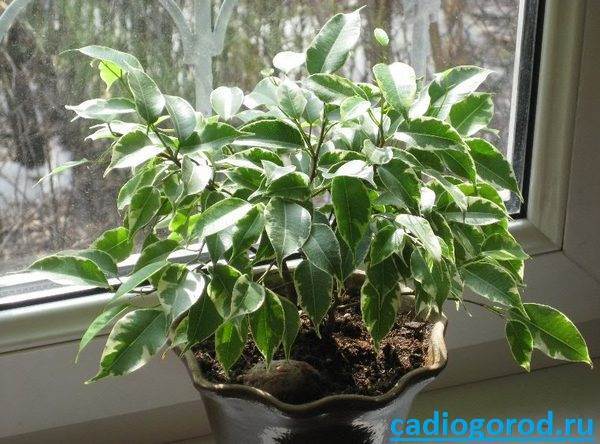
In the photo ficus Benjamin
Tiny ficus belongs to the category of ampelous. They are all spectacular in hanging planters but are picky about leaving. Easier to start ficus benjamin... It is also creeping, but it can acquire the shape of a tree. To do this, it is enough to weave thin trunks. Gradually, they will grow together, forming a single and powerful crown base.
Ficus Benjamena at home easily tolerates a haircut. This simplifies the formation of the crown. The foliage in it is small, pointed at the ends. The grooves allow excess moisture to drain off. Homemade ficus Benjamen does not fatigue from moisture, rather, needs it. Frequent spraying is required.
Ficus Benjamin - photo, often standing next to the Rubber species. He was one of the first to be “tamed”. Ficus belongs to trees, grows tall. Leaves alone reach 30 centimeters in length.
Young foliage is rolled into a tube. They are covered with reddish stipules. Later, the oval "canvases" open up, acquiring a dark green color.
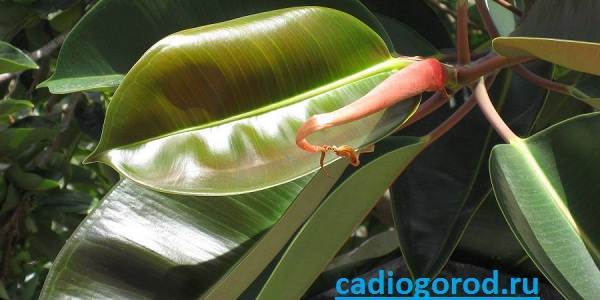
Ficus Rubber- long-liver. It is he who is called Sacred in India, associating with the personality of Buddha. The tree has one trunk at the beginning of life. But, over the years, the ficus begins to branch and grow. As a result, an array of trees is obtained, the trunks of which grow together, intertwine.
So Bengali ficus at home will also be covered with aerial roots. For aesthetics, they are most often removed. It also helps control the size of the tree.
Ficus Ali stands out with non-standard foliage. It is long and thin. If you weave the trunks of several trees, you get a composition that resembles a palm tree. Growing Ali, florists call tango with ficus... Shaping the plant into the desired shape is like a dance or the work of a sculptor. The tree makes it possible not only to care for it, but also to act as a creator.
The trunk of the Triangular Ficus is not so plastic. Foliage also requires attention. It was its shape that became the reason for the plant's criticism. Its leaves seem to be chopped off in the middle, resembling triangles. And what does the process of caring for ficuses resemble? Is this torture, or is it a simple exercise?
Ficus care at home
As inhabitants of the tropics, ficuses die if the temperature drops below 12 degrees Celsius. The ideal indicator is 20-25 degrees. This is exactly what is required during the growth period. It lasts from spring to autumn. At this time, plants require more water, frequent watering. In winter, ficuses are drunk only once every 10-13 days. The same gap is for fertilizing the soil, which is applied in summer.

What else requires ficus? Home care implies transplanting, but only young plants. They renew the soil every two years. Adult trees do not need to be replanted at all. The main thing is to choose the right soil. The best way: - a mixture of peat, turf, sand and leafy soil. Sod prevails.
Ficus pots are selected tight. This restricts the growth of trees. For example, the rubber-bearing species in nature reaches 30 meters in height. At home, ficus will "pacify" only the lack of soil. Plants may also lack light.
Representatives of the family simply put up with penumbra. The exception is variegated ficus. Care behind it assumes a well-lit room. Otherwise, the decorative coloring will be lost.
Ficuses do not like to change their position. Frequent rearrangements of trees lead to foliage falling. Over-watering has the same effect. Water should not remain in the pan. At the same time, the fall of the lower foliage in treelike ficuses is the norm. And what is the cost rate if you buy it in a store?
Ficus price
Since most ficuses are trees and shrubs, their price depends on their size. Large specimens are the result of years of plant care. Therefore, you will have to pay at least 3,000 rubles for the ficus. Young shoots can be purchased for 300-400 rubles. So much will be asked, for example, for a 25-30-centimeter Benjamin ficus.
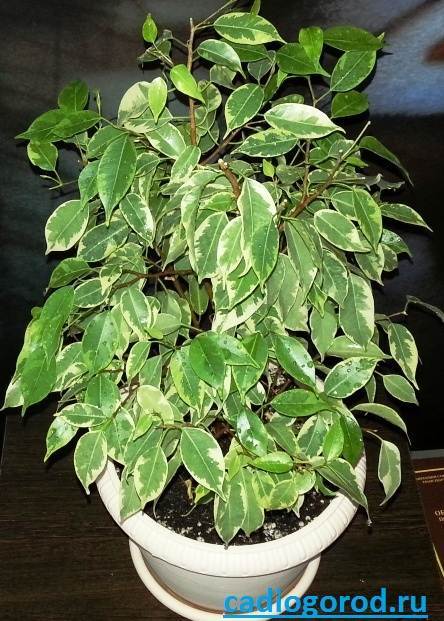
Fork, as a rule, falls for the plants of the design plan. If the trunks are woven into a complex pattern, the crown is framed, the tree will not cost less than 5,000 rubles. The same applies to compositions on a lattice and ficuses with artificially twisted trunks like young bamboo shoots.
The pot also affects the price. Typical variant made of plastic makes the purchase cheaper. A ceramic, spectacular pot is many times more expensive. Variegated plant species are usually more expensive.